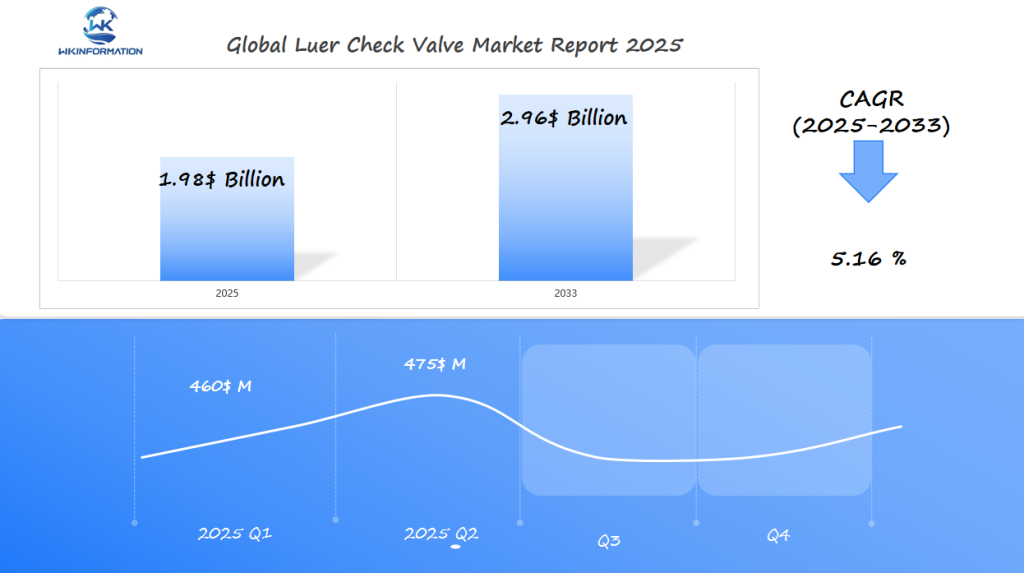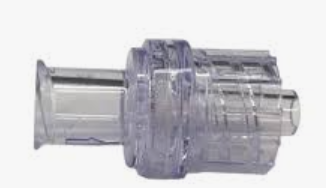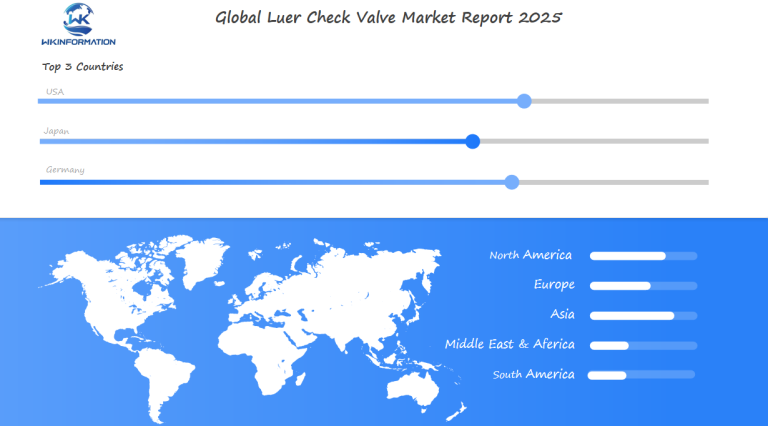Luer Check Valve Market in 2025 with $1.98 Billion Insights and Growth Potential from the US, Germany, and Japan
Explore the Luer check valve market’s growth in the US, Germany, and Japan, driven by innovation and healthcare demands by 2025.
- Last Updated:
Luer Check Valve Market Forecast for Q1 and Q2 of 2025
The Luer Check Valve market is projected to grow from USD 1.98 billion in 2025, with a CAGR of 5.16% during the forecast period. In Q1 2025, the market is expected to reach approximately USD 460 million, driven by increasing demand in the medical and pharmaceutical sectors, especially for devices such as infusion pumps, IV sets, and diagnostic tools. By Q2 2025, the market is anticipated to grow to about USD 475 million, as healthcare innovations continue to fuel the need for reliable, efficient valve systems.
The US, Germany, and Japan are key players in this market. The US leads due to its large medical device manufacturing sector and advancements in healthcare technology. Germany, known for its precision engineering in medical devices, follows closely, with the demand growing for specialized valve applications. Japan, with its strong focus on healthcare technology and aging population, is also a significant contributor to the market’s growth.

Understanding the Upstream and Downstream Impact on the Luer Check Valve Market
To fully understand the complexities of the healthcare supply chain, it’s important to know how the upstream and downstream factors affect the Luer check valve market.
Upstream Impact: Influencing Factors in Production
Upstream impact refers to factors influencing the initial stages of production, including:
- Raw material availability
- Technology advancements
- Manufacturing innovations
These factors play a crucial role in shaping how Luer check valves are produced.
Downstream Impact: Factors Affecting Distribution and End-Use
On the other hand, downstream impact encompasses aspects affecting product distribution and end-use, such as:
- Market demand
- Regulatory landscapes
- Consumer preferences
These elements directly influence how Luer check valves are distributed and used in various healthcare settings.
The Shift Caused by Advancements in Medical Technology
Recent advancements in medical technology have significantly changed both upstream and downstream dynamics within the Luer check valve market.
Increased Demand for Luer Check Valves
The rise of minimally invasive procedures has led to a greater need for Luer check valves. These procedures often require specific design features that manufacturers must accommodate during production.
Changes in Production to Meet Design Requirements
In response to this increased demand, manufacturers are making adjustments to their production processes. They are focusing on incorporating key attributes such as:
- Enhanced precision
- Reliability
- Biocompatibility
These qualities are essential for meeting the demands of minimally invasive procedures and ensuring optimal patient care.
The Importance of Luer Check Valves in Healthcare
Luer check valves serve a purpose beyond their mechanical function; they are critical components in patient care and medication delivery systems.
Ensuring Accurate Medication Delivery
By preventing backflow and allowing only unidirectional flow, these valves play a vital role in ensuring that medications are delivered accurately without contamination. This is particularly important in infusion therapies where maintaining sterility and precise dosing is crucial.
Significance in Various Healthcare Settings
Both hospital and non-hospital environments rely on Luer check valves for safe drug administration. In-home healthcare settings, for example, depend on these valves to ensure proper medication delivery, highlighting their significance across different healthcare contexts.

How Geopolitical Factors Shape the Luer Check Valve Market
Geopolitical stability plays a crucial role in shaping healthcare markets globally, impacting regions where Luer check valves are extensively used. Political stability ensures consistent healthcare funding and policy-making, fostering an environment conducive to medical innovations. For instance, countries like the United States, Germany, and Japan benefit from stable political climates that support their advanced healthcare infrastructures and innovation-driven markets.
Trade Policies and Supply Chains
Trade policies significantly affect the supply chains for Luer check valves. Tariffs or restrictions that arise from political tensions between countries can lead to increased costs and disrupted supplies. For example, tariffs imposed on raw materials or finished products can increase production costs for manufacturers, which may be passed on to healthcare providers and ultimately patients.
Geopolitical Tensions and Availability of Medical Components
In some cases, geopolitical tensions may result in export bans or trade embargoes affecting the availability of vital medical components. This situation necessitates strategic planning by manufacturers to mitigate risks associated with such disruptions. Diversifying supply sources and maintaining flexible manufacturing operations are strategies that can buffer against potential geopolitical shifts.
However, it’s important to note that geopolitics and fragmentation also emerge as serious financial stability threats. Understanding these global market dynamics helps stakeholders anticipate challenges and adapt proactively to maintain a steady supply of Luer check valves amidst changing geopolitical landscapes.
Understanding Luer Check Valve Market Segmentation by Type
Understanding the market segmentation in the Luer Check Valve Market is crucial for identifying specific applications and meeting healthcare demands effectively. Various types of Luer check valves cater to distinct medical needs, each designed with unique specifications to optimize performance and safety.
Types of Luer Check Valves
- Straight-Tube Luer Valves: These are commonly used in settings requiring quick and secure connections. Their streamlined design makes them ideal for cardiovascular care, where rapid fluid transfer is critical.
- Rotating Luer Valves: Featuring a rotatable mechanism, these valves provide flexibility and precision, essential in diagnostic procedures where exact flow control is necessary for accurate results.
- Y-Site Luer Valves: Designed for multipoint connections, these valves facilitate concurrent infusion therapies, making them indispensable in intensive care units.
Application Areas
Luer check valves find applications across various medical fields:
- In cardiovascular care, they ensure reliable fluid management during procedures like angiography.
- For diagnostics, their role is vital in maintaining sterile pathways for sample collection and testing.
- In home healthcare settings, these valves support safe medication delivery systems for chronic disease management.
Each type meets different clinical requirements, underscoring the importance of selecting the right valve to enhance treatment outcomes and patient safety.
Global Growth Insights into the Luer Check Valve Market
The global Luer check valve market is experiencing steady growth due to rising demand in the healthcare, pharmaceutical, and medical device industries. Increasing demand for medical connectors and fluid control devices, driven by the rise in hospitalizations and home healthcare services, is a key factor influencing market expansion. Advancements in minimally invasive surgical procedures have led to higher adoption of Luer check valves for precise fluid control. Additionally, stringent healthcare regulations emphasize safety and contamination prevention in medical applications. Technological innovations in material science are also resulting in improved valve durability and biocompatibility.

US Market Dynamics for Luer Check Valves
The United States plays a critical role in the Luer check valve market, with strong demand driven by a well-established healthcare infrastructure, leading to significant consumption of medical connectors. Increased investment in research and development fosters innovation in medical device manufacturing. Growing preference for disposable medical components reduces cross-contamination risks and improves patient safety. Furthermore, the presence of key industry players contributes to a competitive market with ongoing product advancements.
Japan's Influence on the Luer Check Valve Market
Japan is a major player in the Luer check valve market, known for its technological advancements and high standards in medical device manufacturing. Strong government support for healthcare innovation encourages the development of advanced fluid control solutions. The country’s aging population and rising healthcare needs lead to increased demand for efficient medical devices. Additionally, high adoption of robotic-assisted surgeries requires precise and reliable Luer check valves. The presence of top medical equipment manufacturers in Japan drives continuous improvements in product quality and performance.
Germany’s Position in the Global Luer Check Valve Market
Germany is a key hub for medical device production and innovation, influencing the Luer check valve market through a highly regulated medical industry that ensures the development of high-quality and safety-compliant products. The country has a strong focus on medical research and engineering, driving continuous technological improvements. Growing demand for high-performance fluid control components, particularly in diagnostic and therapeutic applications, further supports market growth. Additionally, Germany’s expanding exports of medical devices strengthen its global market presence.
Anticipating Future Developments in the Luer Check Valve Industry
The Luer check valve market is set to evolve with several emerging trends and innovations. The development of smart medical connectors, incorporating sensors for real-time monitoring and safety enhancements, is a notable trend. Increased use of biocompatible and sustainable materials is reducing environmental impact while maintaining product performance. The expansion of telemedicine and remote healthcare services is driving demand for disposable medical components. Moreover, automation and precision engineering enable mass production of high-quality, reliable check valves.
Understanding the Competitive Landscape of Luer Check Valves
-
Terumo Corporation – Japan
-
Medtronic – Ireland (Headquartered in the U.S. operationally)
-
Boston Scientific – United States
-
Smiths Group – United Kingdom
-
Merit Medical – United States
-
Cook Medical – United States
-
Fresenius Kabi – Germany
-
BD (Becton, Dickinson and Company) – United States
-
Neomedic – Spain
-
Cardinal Health – United States
Overall
| Report Metric | Details |
|---|---|
| Report Name | Global Luer Check Valve Market Report |
| Base Year | 2024 |
| Segment by Type |
·PC |
| Segment by Application |
·Hospital |
| Geographies Covered | · North America (United States, Canada)
· Europe (Germany, France, UK, Italy, Russia) · Asia-Pacific (China, Japan, South Korea, Taiwan) · Southeast Asia (India) · Latin America (Mexico, Brazil) |
| Forecast units | USD million in value |
| Report coverage | Revenue and volume forecast, company share, competitive landscape, growth factors and trends |
The Luer check valve market is poised for continued expansion, driven by advancements in medical technology, regulatory developments, and increasing healthcare demands. While North America, Europe, and Asia-Pacific remain dominant markets, emerging economies present significant growth opportunities. Companies that prioritize innovation, quality, and compliance will be well-positioned to thrive in this evolving industry.
Global Luer Check Valve Market Report (Can Read by Free sample) – Table of Contents
Chapter 1: Luer Check Valve Market Analysis Overview
- Competitive Forces Analysis (Porter’s Five Forces)
- Strategic Growth Assessment (Ansoff Matrix)
- Industry Value Chain Insights
- Regional Trends and Key Market Drivers
- Luer Check ValveMarket Segmentation Overview
Chapter 2: Competitive Landscape
- Global Luer Check Valveplayers and Regional Insights
- Key Players and Market Share Analysis
- Sales Trends of Leading Companies
- Year-on-Year Performance Insights
- Competitive Strategies and Market Positioning
- Key Differentiators and Strategic Moves
Chapter 3: Luer Check Valve Market Segmentation Analysis
- Key Data and Visual Insights
- Trends, Growth Rates, and Drivers
- Segment Dynamics and Insights
- Detailed Market Analysis by Segment
Chapter 4: Regional Market Performance
- Consumer Trends by Region
- Historical Data and Growth Forecasts
- Regional Growth Factors
- Economic, Demographic, and Technological Impacts
- Challenges and Opportunities in Key Regions
- Regional Trends and Market Shifts
- Key Cities and High-Demand Areas
Chapter 5: Luer Check Valve Emerging and Untapped Markets
- Growth Potential in Secondary Regions
- Trends, Challenges, and Opportunities
Chapter 6: Product and Application Segmentation
- Product Types and Innovation Trends
- Application-Based Market Insights
Chapter 7: Luer Check Valve Consumer Insights
- Demographics and Buying Behaviors
- Target Audience Profiles
Chapter 8: Key Findings and Recommendations
- Summary ofLuer Check Valve Market Insights
- Actionable Recommendations for Stakeholders

Access the study in MULTIPLEFORMATS
Didn’t find what you’re looking for?
TALK TO OUR ANALYST TEAM
Need something within your budget?
NO WORRIES! WE GOT YOU COVERED!
Call us on: +1-866-739-3133
Email: infor@wkinformation.com
How do upstream and downstream impacts affect the Luer check valve market?
Upstream impacts refer to factors affecting production, such as advancements in medical technology, while downstream impacts relate to how these valves influence patient care and medication delivery systems.
What key trends are shaping the Luer check valve market for 2025?
Key trends include a rise in demand for minimally invasive procedures, technological innovations enhancing durability and biocompatibility, and an increasing focus on home healthcare solutions.
What challenges do manufacturers face in the Luer check valve market?
Manufacturers encounter challenges such as regulatory compliance issues that impact market entry and product development timelines, as well as competition from established players and new entrants.
How do geopolitical factors influence the Luer check valve market?
Geopolitical stability affects healthcare markets globally, particularly in regions where Luer check valves are widely used. Trade policies can also impact supply chains through tariffs or restrictions due to political tensions.
What types of Luer check valves are available in the market?
The market offers various types of Luer check valves tailored for specific applications across medical fields, including cardiovascular care and diagnostics.


